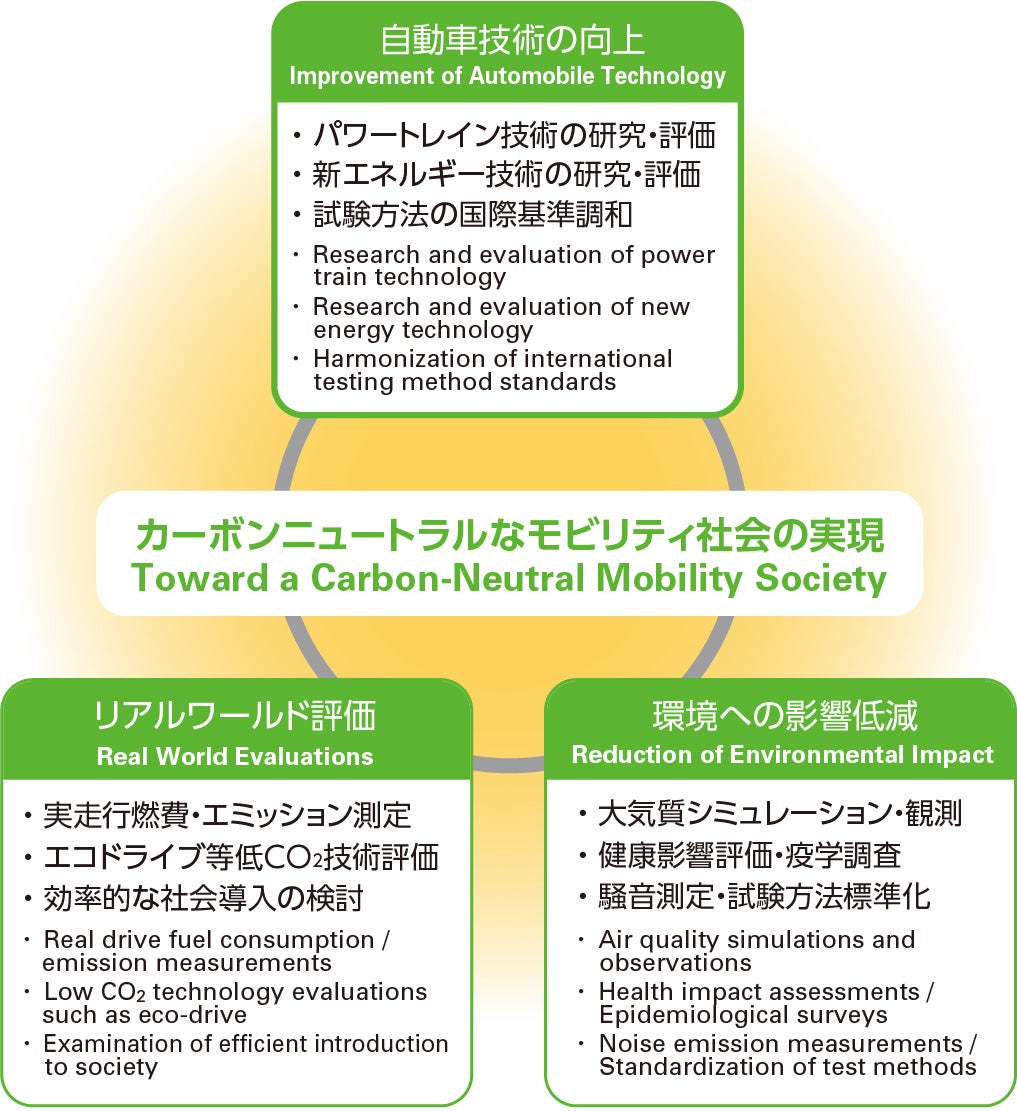Environment
Research Overview
With the demand for environmental improvement of automobiles, carbon neutrality for the entire life cycle of automobiles is expected worldwide by 2050. Research areas related to CO2 reduction during driving include improvement of fuel efficiency of automobiles with internal combustion engines and harmful substances emitted from automobiles, and in recent years, surveys and research on the electrification of automobiles have been increasing. With the goal of "realizing a carbon-neutral mobility society", JARI is comprehensively implementing research activities in related fields, covering everything from internal combustion engine automobiles to electric vehicles (xEV).

In the area of research on internal combustion engine vehicles, we conduct comprehensive research activities in a wide range of related fields, such as investigation of the properties of various fuels, clarification of their formation mechanisms in engine combustion chambers, research on combustion and exhaust aftertreatment technologies, development of measurement methods and test methods necessary for research, research on advection and diffusion and chemical reactions after release into the atmosphere, and health effects assessment and epidemiological studies of hazardous substances. In addition, we also conduct research on internal combustion engines for automobiles. In addition, we participated in the Research Association for Automotive Internal Combustion Engine Technology to conduct basic and applied research on engines, and in the Japan Automotive Model-Based Engineering Center to conduct new research related to model-based development. In 2021, we started research on the entire life cycle of automobiles (Well-to-Wheel evaluation of next-generation vehicles and life cycle assessment (LCA)).
In the fields of exhaust gas emissions methods and noise test methods, we are involved in new research to reduce the environmental load of automobiles in the real world, such as research areas utilizing vehicle test facilities that can reproduce the environmental temperatures (-40 to +50℃) and investigating emissions from tires and brake frictional particles, or emissions other than exhaust gas. Regarding research on xEV, we are involved in matters such as the promotion of standardization and normalization, and, while also serving as the domestic deliberative body of the international electric vehicles standards (ISO/TC22 (automobiles)/SC37 (EV), IEC/TC69 (BEV and electric industrial vehicles)) we draft plans and comments related to international standards (ISO/IEC) associated with FCV, BEV and HEV with the cooperation of industry, government, and academia. In performance evaluation, we are conducting research to improve performance, develop evaluation methods, and expand charging infrastructure for electric vehicles, motors/inverters, batteries, fuel cells, and chargers. Regarding batteries, we are working on the development of suitable life span evaluation technology for lithium-ion batteries and research to understand the degradation mechanism. In the safety evaluation research of hydrogen, high-pressure containers, and batteries, we are working on research that contributes to the development of safe electric vehicles by utilizing Hy-SEF (Hydrogen and Fuel Cell Vehicle Safety Evaluation Facility).
Principal research areas
Main test items
JARI has a variety of chassis dynamometer systems of different sizes to test a whole range of vehicles from mopeds and motorcycles to 25 ton heavy duty trucks as well as gasoline, diesel and CNG engines. Our noise measuring equipment can measure vehicle prototypes to in use vehicles along our test courses capable of providing diverse running conditions. These systems and equipment enable JARI to test the following items:
- Exhaust emissions including hazardous trace substances
- Fuel economy
- Durability
- Evaporative gas from gasoline vehicle
- Vehicle/running noise
- Onboard component systems such as emissions after treatment devices
- Automotive fuel properties
- Running tests for traffic survey and vehicle assessment
Over the recent years JARI's testing activity has expanded into the non automotive fields including construction machinery and industrial engines, and into the test areas relating to automotive parts such as the dust generated through the abrasion of tires and brakes.
- Electric vehicle testing
- Battery performance evaluation
- Fuel cell performance evaluation
